Tracking visitor numbers at city events in Rees: New methods revealed
In the picturesque city of Rees, located in western Germany, a significant step towards modern urban planning and city marketing has been taken. The city administration has allocated budget funds for a year-long laser-based pedestrian frequency measurement in the city centre.
The aim is to gain detailed data on visitor numbers and pedestrian movements in the central city area. This data will help the city administration and local actors, such as retailers, gastronomy, and service providers, better understand visitor numbers at different times and on different days.
The laser-based pedestrian frequency measurement uses a laser scanner or LiDAR sensor to count and track pedestrian flow by detecting movement patterns without capturing personally identifiable information (PII). This innovative approach offers a non-intrusive method to monitor foot traffic in public spaces.
The data collected is intended to provide valuable insights, such as accurate data on pedestrian flows for optimizing public spaces and retail locations, evidence to support urban planning decisions and infrastructure improvements, and enhanced marketing strategies targeting peak times or popular zones. Moreover, it can contribute to improved safety by monitoring crowded areas.
The city administration states that the Rhine Festival provided positive experiences for the laser-based pedestrian frequency measurement. Retailers, gastronomy, and service providers benefited from reliable figures that facilitated the planning of actions and store opening hours.
A laser scanner has been installed on Dell Street at the height of the Volksbank for the measurement. It records pedestrian movements using laser beams and generates a point cloud. Over a longer period, this data collection is necessary for the measurement to provide valuable insights into the impact of cultural events, weather conditions, or tourist events on pedestrian movements.
It is essential to note that such systems generally comply with data protection laws when they do not store or process personal data (no video or identifiable images) or anonymize data immediately. In Germany, where Rees is located, strict privacy regulations apply requiring transparency and data minimization. The data collected during the measurement in Rees is legally unobjectionable from a data protection point of view as no live images are stored during data collection.
This innovative approach to urban planning and city marketing in Rees is expected to provide valuable insights that will help the city and its local actors make informed decisions for the betterment of the city and its community.
- The use of smart-home devices, such as laser scanners and LiDAR sensors, has been integrated into Rees's city planning strategy, offering a non-intrusive method for monitoring foot traffic in public spaces.
- The data collected from home-and-garden gadgets like these sensors will contribute to a more comprehensive understanding of lifestyle trends, including pedestrian movements in the city centre.
- This technological advancement in Rees, Germany, could potentially extend beyond city planning, as the insights gained from such measurements could be applied to fields like education-and-self-development, general-news, and even shopping trends.
- With the collected data providing evidence for urban planning decisions and infrastructure improvements, the city administration and local actors may find it beneficial to adopt similar technology solutions in other areas of city management, further emphasizing Rees's commitment to modern urban planning and city marketing.




